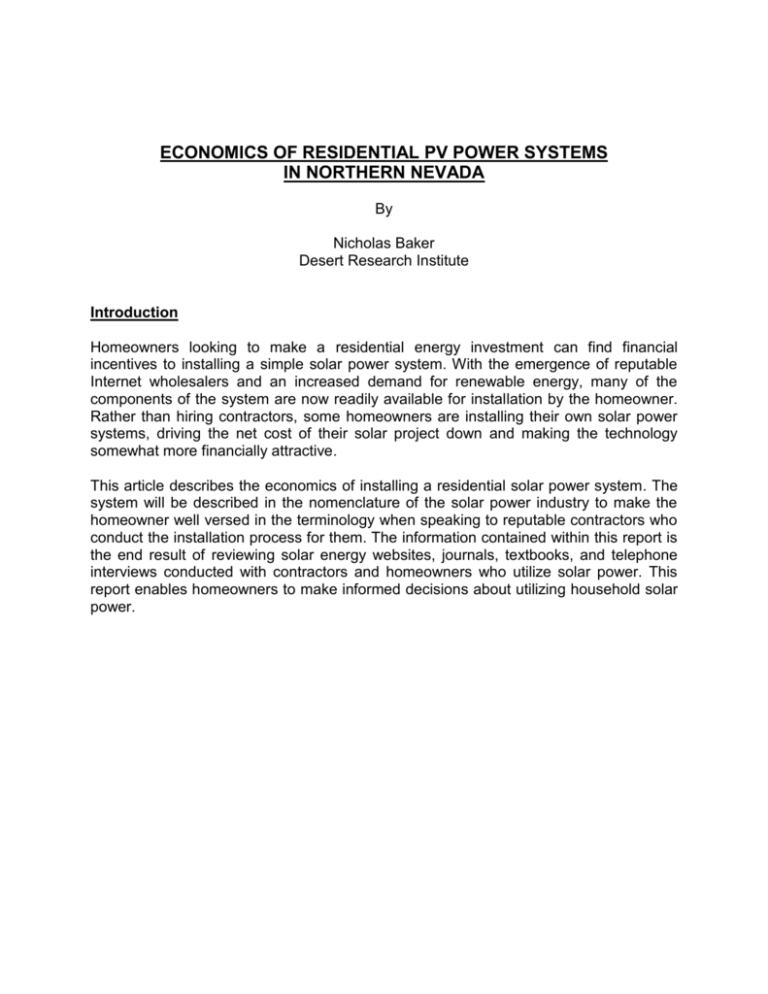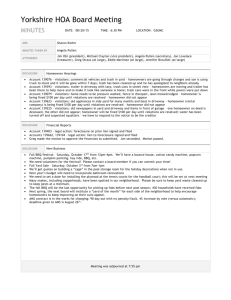Economics of Residential PV Power Systems
advertisement

ECONOMICS OF RESIDENTIAL PV POWER SYSTEMS IN NORTHERN NEVADA By Nicholas Baker Desert Research Institute Introduction Homeowners looking to make a residential energy investment can find financial incentives to installing a simple solar power system. With the emergence of reputable Internet wholesalers and an increased demand for renewable energy, many of the components of the system are now readily available for installation by the homeowner. Rather than hiring contractors, some homeowners are installing their own solar power systems, driving the net cost of their solar project down and making the technology somewhat more financially attractive. This article describes the economics of installing a residential solar power system. The system will be described in the nomenclature of the solar power industry to make the homeowner well versed in the terminology when speaking to reputable contractors who conduct the installation process for them. The information contained within this report is the end result of reviewing solar energy websites, journals, textbooks, and telephone interviews conducted with contractors and homeowners who utilize solar power. This report enables homeowners to make informed decisions about utilizing household solar power. Figure (1): Components and description of a grid-tied residential photovoltaic (PV) power system. Figure (2): Components and description of an off-grid residential photovoltaic (PV) power system. 1 Residential Solar Power System Overview I. Direct Sunlight Figures (1) and (2) depict sunlight falling on silicon photovoltaic (PV) cells. This creates a reaction within the solar panel (also known as a “PV array”) that can generate the useful direct current (DC) that will either directly supply or supplement the power needs of a residence. The amount of sunlight that reaches the system determines how much power the system is able to create. Abundant year-round insolation (incoming sunlight) makes Northern Nevada an ideal location for solar power [1]. II. PV Array The PV array consists of thousands of individual cells wired in series to generate enough current to be useful. The solar panels themselves are generally mounted on roofs of existing buildings or designed to be an integrated part of the roof itself, depending on the application. PV ground arrays are also installed. This facilitates system cleaning and seasonal adjustment. Since the power generated by the system is directly related to the amount of light the array gets during daytime hours, the placement and orientation of the PV array affects the amount of power it is capable of producing [2]. If possible, the array should be adjusted seasonally to the appropriate angle to receive the largest amount of direct sunlight from month to month or season to season. If the angle of the roof or location on which the system is mounted is too low or too high the homeowner will notice a substantial difference between the power generated during summer and winter months. There are many resources available online to determine the optimum angular orientation of the array, one of which is listed in Appendix B. The optimum location for a solar power system is an area that receives the maximum amount of sunlight throughout the year. Factors that can decrease power output include surrounding temperatures in the extremes (either exceptionally cold or hot climates), dust/dirt accumulation, and inconsistent wiring of the arrays. These losses associated with the functionality of the array are typically called the system’s “derating factor” [3]. It is important to note that many PV products are rated in DC power output, while the useful alternating AC power that the residence will actually be able to use after the DC power conversion process to AC will be roughly 77% of the DC value. III. Charge Regulator/Power Conditioning As the amount of sunlight that hits the PV array is prone to variations throughout the day and year (i.e. shade from passing clouds, overcast days, etc.), the charge regulator and power conditioner are vital components of the system. Any inconsistencies in the lighting can cause individual cells to act as diodes and discharge any current generated by neighboring cells. The charge regulator can detect these discrepancies and correct them using a series of blocking diodes to temporarily reroute the current flowing through the system. It is a necessary component to make sure the power is safely distributed from the entire PV system. 2 IV. DC/AC Inverter The direct current (DC) power generated by the PV array is not useful for most residential appliances. At this point in the system, the direct current is fed through a power inverter that converts it to the alternating current required by most appliances and wall outlets within the residence. The DC-to-AC inverter is an essential component in both on-grid and off-grid applications since a vast majority of household appliances use AC. Inverters operate under high stress due to variations in the load that is being applied through them. They require periodic conditioning to ensure optimal operation, but can last for almost the lifetime of the entire system if maintained properly. Losses in power are also associated with the inversion process, again contributing to the system’s derate factor [3]. For grid-tied PV systems, the DC-to-AC inverter also feeds excess power generated back to the power utility, essentially running the homeowner’s energy meter backwards. This is where the financial savings manifest themselves in the form of generating power credit to the homeowner, thus lowering the monthly power bill. This practice is known as “Net Metering,” and is commonly practiced within urban/suburban residential PV systems. The effectiveness of Net Metering is discussed in further detail in the Financial Impact to Homeowner section. V. Battery System for Off-Grid Applications A battery system for energy storage is an optimum choice for residences that are remotely located and thus required to operate independent of the traditional power grid. Power not immediately used within the residence is fed to a DC-to-DC converter and is in turn used to charge a lead-acid battery system. Although not required in every PV application, the battery system ensures all energy harvested from the sun’s rays are converted to some useful form of power, storing enough power to accommodate night time demands. The batteries can also be used for power if the PV array is damaged or out of service temporarily. It is important to note that the batteries have a shelf life, as do the other components of the residential PV system, and require periodic maintenance and discharge to ensure proper power distribution to the rest of the system. VI. End Use The end result of the PV system is to power fixtures and appliances throughout the household. Since there are no waste byproducts created during the PV power generation, PV energy is arguably one of the most ecologically benign sources of electrical power. Despite this fact, the technology required to harness solar power remains fairly expensive and not yet cost effective, but costs are declining as newer PV techniques, materials, and financial incentives become available. 3 To estimate how large a system should be, review the residence power usage over the past year(s), and then decide how much of this power the homeowner wants to have generated by a PV system. It is a good idea to build a solar power system above estimated demands, as there are power losses that occur during the power conversion process and through normal use. Table (1) shows sample calculations on the sizing of a PV system based on energy usage. Data and assumptions for these calculations can be found in the spreadsheet located in Appendix A and in the Financial Impact to Homeowner section below. Table (1): Sample PV system size estimator for Northern Nevada System Power Usage % of Power to Output System Size Season by Season be supplied by Demand Needed for % [kW-h] PV System [kW] Power Specified 50% 1.4 April2255 50%: 1.6-2.0 kW 75% 2.1 September 90% 2.6 75%: 2.3-2.8 kW 50% 1.7 October2594 75% 2.5 March 90%: 2.8-3.3 kW 90% 3.0 Once installed, the PV array requires little periodic maintenance, generally a semiannual cleaning of the array to remove any debris from the cells that can cause performance losses is generally sufficient for the majority of residential applications [1]. Many PV cells can have a life longer than 25 years, but damage to cells can occur at any time. The warranty period for the majority of the PV arrays available on the market is 25 years as well [2]. It important for the homeowner to check the system at least once a month to make sure all components are operating at peak capacity. VII. Financial Impact to Homeowner a.Tax Incentives The bottom line to homeowners is how much the switch to solar power will cost them out of pocket and what they can expect for a normal payback period. Tax rebates are offered by the Federal Government to help offset the capital needed to install the system. In many instances, these rebates can be up to a third of the system’s entire cost. Although currently inactive in Nevada (early 2012), many states offer incentives for renewable energy as well. Contractors interviewed for this report suggested homeowners view the cost of the solar power systems as a long-term investment in their home and suggested a simple payback period for an average size solar system in Northern Nevada as 16 years when external financial incentives are applied; see Table (2). For this report, contractors were asked to supply a cost per Watt quote for an average 4 residential system. Estimates for how large an average solar power system should be ranged from 1.8-3 kW (kW = 1000 Watts) capacity, and the cost of installation per Watt ranged from $6.00-7.50, brining the final bill to the range $10,000-20,000. NV Energy offers an incentive once a year that is available to homeowners who install a PV system to help offset the up front (capital) costs. NV Energy will reimburse the homeowner $2.30 per AC Watt that the system can generate up to $23,000 (NV Energy SolarGen). Homeowners can get a crude estimate of how much they can expect to receive by multiplying their system size (i.e.-1,800 Watts) by the common output derating value (roughly 0.77), and then multiplying this number by the incentive value. Adding to this, the Federal Government offers a tax credit of 30% of the system cost after NV Energy’s incentive to reduce the final cost of the system to the homeowner. To verify contractor claims, these figures were tabulated along with the amount of solar radiation available in Northern Nevada. Table (2) contains estimates for the cost and payback period of a simple PV system for energy usage outlined in Table (1). The assumptions made for the calculations of this data are: the cost of installation is $6.00/Watt, the panels produce around 10W/ft2, and an annual increase in energy prices of 1% to determine the value of the power generated by the system. Alternative uses of money are not considered in Table (2). Figure (3) shows the net cash flow over the average warrantied lifetime of the PV systems outlined in Table (2). Table (2): Estimates of a contractor-installed PV system cost and payback period in Northern Nevada. System Estimated up- NV Energy 30% Simple Size front cost to SolarGen Federal Net Cost to Payback [kW] homeowner Incentive Tax Credit Homeowner Period 1.8 $10,800 $3,188 $2,284 $5,329 17 years 2.5 $15,000 $4,428 $3,172 $7,401 15.8 years 3 $18,000 $5,313 $3,806 $8,881 15.8 years 5 Fig. (3): Net Cash flow for sample contractor-installed PV system in Northern Nevada with a 1% annual increase in energy prices. Due to the high availability of online PV kits and many homeowners interested in performing a majority of the installation on their own, this was self-installation scenario is outlined in Table (3) below. The assumptions made for the calculation of Table (3) is that the homeowner will do about 25% of the system installation. Figure (4) visualizes the net cash flow for the average warrantied lifetime of a PV system. Complete calculations of this data can be found in Appendix A at the end of this article. Table (3): Estimates of a homeowner and contractor-installed PV system cost and payback period in Northern Nevada. System Estimated up- NV Energy 30% Size front cost to SolarGen Federal Net Cost to Payback [kW] homeowner Incentive Tax Credit Homeowner Period 1.8 $8,100 $3,188 $1,474 $3,429 12.3 years 2.5 $11,250 $4,428 $2,047 $4,776 11.3 years 3 $13,500 $5,313 $2,456 $5,731 11.3 years 6 Fig. (4): Net Cash flow for sample homeowner and contractor-installed PV system in Northern Nevada. A reasonable methodology to evaluate the pros and cons of installing a PV power system is to use the same decision criteria used by major companies: by looking at the return on the initial investment. By comparing this value to things like the amount of interest a similar amount of money may generate in an alternative investment, the homeowner is able to get a better concept of the economic attractiveness of PV power. Sample returns on initial investments can be found in Table (4) for both types of systems described above; information on how to calculate these values can be found in Appendix A. Table (4): Return on investment in Northern Nevada for various system sizes from sample calculations, which include rate-payer and tax-payer support. First year Average Return System Size Installation Type Return on on investment investment over 25 years 1.8 kW Contractor only 5.41% 6.12% 2.5 kW Contractor only 5.85% 6.61% 3 kW Contractor only 5.85% 6.61% 1.8 kW Contractor & Homeowner 8.39% 9.48% 2.5 kW Contractor & Homeowner 9.06% 10.24% 3 kW Contractor & Homeowner 9.06% 10.24% 7 It is important for homeowners to understand all that installing a PV system entails to ensure optimum performance at a fair price. As such, many helpful links and resources for the interested consumer have been compiled and can be found in Appendix B. Beyond the capital costs of installing a PV system, homeowners need to be licensed on a local, state, and Federal level to operate a solar power system. The utility company also needs to set up the appropriate accommodations for the power to be fed back to the energy grid in order for the system’s Net Metering to work properly. All of these bureaucratic items can take weeks or even months to be in effect for the homeowner so it is important the homeowner understands the length of the process before investing in a PV system [4]. b. No-incentive cost To demonstrate the large effect of federal, state and utility incentives when offsetting the capital needed to purchase the PV system, a brief analysis was conducted without including these discounts in the net system cost to homeowner for the same system sizes discussed previously. The assumptions made for these iterative calculations are the same as those listed in the previous section. Table (5) can also be considered the total system societal cost, since costs defrayed to the homeowner must be assumed by the taxpayer and ratepayer. The payback periods in Table 5 exceed the 25 year warrantee offered by vendors. Table (5): Estimates of a contractor-installed PV system cost and payback period in Northern Nevada, less incentives. System Size [kW] Net Cost to Homeowner Payback period 1.8 $10,800 31 years 2.5 $15,000 29.1 years 3.0 $18,000 29.1 years 8 Fig. (5): Net Cash flow for sample contractor-installed PV system in Northern Nevada with a 1% annual increase in energy prices, less incentives. The payback period for systems purchased with no incentives increases by nearly a factor of two for all three considered system sizes, thus diminishing the value of installing PV (Fig. 5 & Table 5). Even if homeowners are able to do part of the installation themselves the payback period is still almost 25 years (Fig. 6 & Table 6): Table (6): Estimates of a homeowner and contractor-installed PV system cost and payback period in Northern Nevada, less incentives. System Size [kW] Net Cost to Homeowner Payback Period 1.8 $8,100 24.1 years 2.5 $11,250 23.8 years 3 $13,500 23.8 years 9 Fig. (6): Net Cash flow for sample homeowner and contractor-installed PV system in Northern Nevada, less incentives. The return on investment decreases by roughly 55% for both the first year and over the first 25 years of the system’s ownership as well (Table 7). This further demonstrates how PV technology still needs to develop methods to decrease the cost to the end user in order for PV to assume a strong foothold in the energy market. Table (7): Return on investment in Northern Nevada for various system sizes from sample calculations. First year Average Return System Size Installation Type Return on on investment investment over 25 years 1.8 kW Contractor only 2.67% 3.02% 2.5 kW Contractor only 2.89% 3.26% 3 kW Contractor only 2.89% 3.26% 1.8 kW Contractor & Homeowner 3.56% 4.02% 2.5 kW Contractor & Homeowner 3.85% 4.35% 3 kW Contractor & Homeowner 3.85% 4.35% 10 Homeowner Statement An interview was conducted with a Northern Nevada homeowner about his family’s decision to install a residential solar power system through a contractor. The homeowner started his PV project by sourcing a contractor through a home improvement store’s list of contacts. The initial contact from the contracting company assured the homeowner that the installation would be straightforward and that they would walk the family through the system’s operation and maintenance procedures prior to installation. They would also explain how the system would be integrated to the residence’s current power needs. The contact estimated a 1.4 kW system with a price tag of $15,000 but stated the payback period would be 7-8 years. The homeowner said that the contact acted pushy during the consultation process and seemed to be out for a fast sale. When it came time to arrange for the contracting company to actually install the system, the homeowner was told his initial contact at the company had been let go, but that the contractors would still be able to describe the system’s functionality to the family. The homeowner felt wary about his decision but decided to go ahead. When the contractor came to the residence for the system installation, the workers were less than professional and failed to show the homeowner how the system would operate. After the installation was completed, the homeowner found he had to spend considerable time acquiring the appropriate licenses and permits to use the system. The contractor failed to mention the licensing requirement to the homeowner prior to the system’s installation. The system has been operational for over 6 months (at the time of this interview) and the utility company is yet to come make the appropriate accommodations for the system to net meter and begin to recoup the capital cost. As a whole, the homeowner felt he was oversold a solar power system that costs his family money to use each day. This negative experience demonstrates the importance of finding a reliable contractor and ensuring well-informed decisions prior to purchasing PV systems. Conclusions & Recommendations With current trends in energy prices and technologies, PV power is approaching financially viability. The ease of operation and maintenance, rebates and incentives available to homeowners, and the ecological implications make PV power increasingly attractive to some people. The value of the system will increase as energy prices increase each year, and advances in PV technology continue to make for more efficient panels with longer lifespans. However, it is a ponderous process to integrate the PV system to the residence and power grid with all the required licensing and contacts. But by shifting financial responsibility from the homeowner to taxpayer and ratepayer, in some cases the system can pay for itself from the standpoint of the homeowner in the long term if the system lasts its warranted lifetime. 11 In any case, when solar photovoltaic electric power generation approaches financial competiveness with other fuel sources, electric utility companies will be able to deploy this technology much less expensively than homeowners because they enjoy economy of scale, scheduled maintenance by experts, thoroughly understand every phase of electrical production and integration, and can avoid interminable licensing permits for net metering. Questions for Contractors The questions presented below represent a short list of the few key items any legitimate PV system contractor should be able to answer without hesitation. The list is by no means exhaustive and should be used as a guide for homeowner decisions about installing a PV power system. As with any home project, it is suggested that several competitive estimates be obtained. [5]. o What is the warranty period for each component of the PV system? o Do you offer a warranty on the installation workmanship? o Are you registered with the Nevada State Board of Contractors? Are you licensed to perform installations of PV systems? o What is the derate factor of each type of system configuration you offer? o Do you have any performance curve charts that display the performance of the system under different load conditions (i.e. operation through all four seasons)? o Can you explain how each component in the system works alongside the others to generate power? o What is the cost of each component? Do you offer custom system configurations based on desired performance (i.e. offer a choice between expensive vs. cheaper components)? o What is the payback period offered by installing your particular type of PV system? o Do you have any type of data to back up payback period assertion (i.e. net metering capacity of a typical system along with a projected cost of energy in the future)? o What types of State, Federal, or other rebates are offered by installing a PV system in Northern Nevada? 12 o Are any types of permits required for me to operate the PV system? What is the general turnaround time and cost for applying for these permits? o Do you have any references from previous clients that can attest to your quality of workmanship? o Can I do part of the installation? References [1] Hamilton, Reid. "PV Energy Contractor Interview: Hamilton Solar." Telephone interview. Jan. 2011. [2] The German Energy Society. Planning and Installing Photovoltaic Systems: a Guide for Installers, Architects and Engineers. London [u.a.]: Earthscan, 2009. Print. [3] Coughlin, Jason, and Karlynn Cory. "Solar Photovoltaic Financing: Residential Sector Deployment." National Renewable Energy Laboratory. U.S. Department of Energy, Mar. 2009. Web. Feb. 2011. <http://www.nrel.gov/docs/fy09osti/44853.pdf> [4] Caldwell, Grace. "PV Energy Contractor Interview: Independent Power Corporation." Telephone interview. Feb. 2011. [5] Rader, Bryce. "PV Interviews: Homeowner Statement" Telephone interview. Feb. 2011. ________________________________________________________________ APPENDIX Section A: Financial Analysis of Residential PV System Value 13 The above spreadsheet allows users to input their energy usage data and calculates the payback period and return on investment. Fields that are yellow and orange represent cells that the user can change the values in to vary the inputs (energy usage, solar radiation, annual energy price increase, etc.) and see how each can affect the output data. There are three pages in the spreadsheet: the first page offers a breakdown of the sizing guidelines, the second calculates the payback period of the system, and the third visualizes the information into a bar graph showing the net cash flow over the years. How to use Excel workbook: Table Sheet 1 – Sizing guidelines 1. Obtain residences’ electrical utility bills for 12-month period. (Available electronically at http://www.nvenergy.com/) 2. Input monthly electrical usage (in kW-h) into spreadsheet fields marked in yellow. 3. Input annual solar radiation (in kW-h/m2, http://www.nrel.gov/eis/imby/) and cost per kW-h of electricity (found on utility bill) into spreadsheet fields marked in orange. 4. The spreadsheet will calculate the size of system needed to provide 50, 75, and 90% of usage specified in step 2 (Cells F4-F10), the estimated footprint of the specified system (Cells H4-H10), and the annual expected power output of the system (Cells I4I10). 5. The capital financial impacts of the PV system before incentives and rebates are marked in light green (Cells G4-G10 and J4-J10). Click to the next sheet on the bottom of workbook screen. Sheet 2 – Payback and ROI 6. Sheet 2 of the workbook performs cash flow calculations based on systems specified in steps 1-5. The net cost to homeowner after incentives is calculated for both contractor installed and homeowner/contractor installation types and marked in dark green (Cells F4-F10 and F15-F21). 7. If desired, the annual increase in future energy prices can be varied for comparison (Cell B23, marked in orange). 8. The cash flow and return on investment over an assumed 25-year life is shown towards the bottom of this sheet (Rows 30-90). Click to the next sheet on the bottom of the workbook screen. Sheet 3 – Net Cash Flow Graph 14 9. The net cash flow is visualized in this graph over the assumed life of the system. The system has paid for itself when the net cash flow (y-axis) is equal to zero. The next steps after carrying out the directions listed above would be to start looking at the useful links listed below and begin planning the installation of a residential PV system. It is important to consult as many sources as possible to ensure well-informed decisions are made with confidence. Section B: Useful links for Homeowners This is a shortlist of helpful resources and articles available to consumers about the application of PV energy. o NV State Office of Energy – Miscellaneous information on energy policies and practices in Nevada: http://energy.state.nv.us/ o NV Energy's Solar Generations Program – Information on NV Energy’s rebate program: http://www.nvenergy.com/renewablesenvironment/renewablegenerations/ solargen/ o Nevada Tracks Renewable Energy Credits - Register renewable energy system with the Public Utilities Commission of Nevada, allowing homeowners to track credits for renewable energy: https://www.nvtrec.com/ o Nevada State Contractors Board - Ensure proper installation of PV system by a licensed and bonded contractor: http://www.nvcontractorsboard.com/ o NREL “In My Backyard” PV electricity generation calculator: http://www.nrel.gov/eis/imby/ o PV Tilt Angle Calculator: http://www.alternate-energy.net/angle_calc05.html o Kyocera Solar PV Calculator – 3rd Party Solar Power cost/benefit calculator, including payback period information: http://www.kyocerasolar.com/buy/pv_calculator.html o Federal Renewable Energy Tax Credit Form – Form used for Federal Income Tax credit for utilizing renewable energy: http://www.irs.gov/pub/irs-pdf/f5695.pdf o NREL PVWatts Calculator – Outputs PV system performance based on 15 geographical location, system derating value, and energy costs: http://mapserve3.nrel.gov/PVWatts_Viewer/index.html o NREL PVWatts Interpretation Guidelines – Guidelines on how the results from the PVWatts application may be interpreted correctly: http://rredc.nrel.gov/solar/calculators/PVWATTS/version1/interp.html o California Energy Commission's Consumer Guide to Buying a Photovoltaic Solar Electric System: http://www.energy.ca.gov/reports/2003-03-11_500-03-014F.PDF 16






